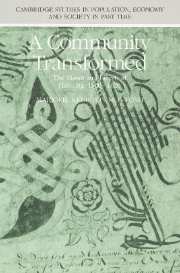Book contents
- Frontmatter
- Contents
- List of figures
- List of tables
- Acknowledgements
- Abbreviations
- Introduction
- 1 Life and death
- 2 Changing economic patterns
- 3 Religion
- 4 Facets of a society in transition
- 5 Havering's declining independence
- 6 Overt conflict, 1607–19
- Conclusion
- Appendices
- Bibliography
- Index
- Cambridge Studies in Population, Economy and Society in Past Time
Conclusion
Published online by Cambridge University Press: 11 October 2009
- Frontmatter
- Contents
- List of figures
- List of tables
- Acknowledgements
- Abbreviations
- Introduction
- 1 Life and death
- 2 Changing economic patterns
- 3 Religion
- 4 Facets of a society in transition
- 5 Havering's declining independence
- 6 Overt conflict, 1607–19
- Conclusion
- Appendices
- Bibliography
- Index
- Cambridge Studies in Population, Economy and Society in Past Time
Summary
A summary of the major themes which link the components of Havering's history between 1500 and 1620 will form a base for comparison between this community in the early seventeenth century and England more generally in the eighteenth century. A central feature in the transformation of Havering after 1500 was the disruption of the common goals and co-operative activity which had been so pronounced in the later medieval period. A number of factors contributed to this change. In demographic terms, heavy immigration introduced newcomers at all economic levels. These people, raised in diverse regions of the country, brought with them a range of attitudes toward private and public matters. Economic developments increased the distance between the wealthiest landed families and the poorest wage labourers and enlarged the contrasts between the types of land use practised at various levels of landholding. In the craft and trading world, men engaged in service occupations flourished, thanks to the ongoing activity of Romford market, while many of the craftsmen fared less well, because of adverse competition with goods made in specialised operations elsewhere. Urban workers at all levels were increasingly separated from the agricultural world.
Divisions within the community were magnified by other factors. After the Reformation, people were separated by divergent religious beliefs, which sometimes accompanied occupational status, and by religious practices, which were largely regional. The rural areas around Havering-atte-Bower chapel showed a far more conservative attitude towards religion than did either Romford town or Hornchurch. Education and culture reinforced the breakdown of shared values. The wealthiest men, often trained at a university and/or in the law, used cultural display to enhance their status.
- Type
- Chapter
- Information
- A Community TransformedThe Manor and Liberty of Havering-atte-Bower 1500–1620, pp. 402 - 411Publisher: Cambridge University PressPrint publication year: 1991

